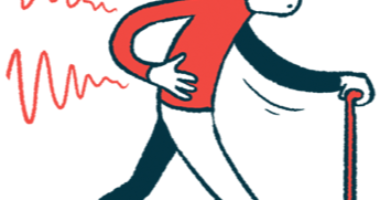Pisa Syndrome in Parkinson’s Tied to Visual/Balance Processing Problems
New virtual reality study reveals deficits due to postural abnormality

Parkinson’s patients with a postural abnormality called Pisa syndrome show deficits in their ability to process visual and balance-related information, a new study done using virtual reality suggests.
“The visual tilting perception assessed in our study is a visual domain task, and our study revealed that [Pisa syndrome] patients displayed impaired visuospatial cognition,” the researchers wrote.
“Rehabilitation focused on visuospatial function in a virtual environment where the inclination of the space can be adjusted freely may be beneficial for [Parkinson’s disease] patients with trunk deviation to correct posture,” the team wrote, adding that “further research is needed to find optimal virtual-spatial conditions for posture correction programs in [Parkinson’s] patients.”
“Impaired virtual space-tilting perception in Parkinson’s disease with Pisa syndrome,” was published in Parkinsonism & Related Disorders. The work was funded in part by Japan’s government and the Japan Society for the Promotion of Science.
Pisa syndrome — referring to a tendency to bend to one side while standing or walking — affects about 10% of Parkinson’s patients. However, the reasons why this syndrome develops in people with the neurodegenerative disorder are not clear.
Researchers have proposed two general hypotheses, one of which is the idea that Pisa syndrome may occur because of abnormalities in the muscles that normally control trunk posture.
Using virtual reality in research
The other hypothesis, called the “central mechanism,” suggests that the syndrome could occur because of imbalances in sensory processing. Such imbalances could cause Parkinson’s patients to have difficulty with balance and orienting their bodies.
Prior studies have shown an association between Pisa syndrome and cognitive difficulties, lending some support to the central mechanism hypothesis.
Now, a team of researchers at Takeda and the Juntendo University Graduate School of Medicine, in Japan, conducted virtual reality (VR) study to assess whether the brain’s processing of visual and spatial information is altered in people with Pisa syndrome.
“We aimed to analyze the relationship between PS [Pisa syndrome] and visual-spatial functions using a virtual three-dimensional tilt test in a virtual reality space,” the scientists wrote.
Their study involved 16 Parkinson’s patients with Pisa syndrome, dubbed the PS+ group. It also included an equal number of Parkinson’s patients without Pisa syndrome — the PS- group — and people without Parkinson’s, who served as controls.
The average age in all groups was in the mid-60s. Measures of disease severity were generally comparable between the two Parkinson’s groups, though the PS- group was on a higher average dose of levodopa.
All participants completed a battery of standardized tests measuring cognition and perception. Notably, the PS+ group scored significantly worse than the PS- group on the Subjective Visual Vertical (SVV) test, which measures a person’s ability to perceive things vertically, or up and down.
This finding “is in line with previous studies showing that vestibular perception and/or cognitive deficits such as altered visual-spatial functions have been considered to play an important role in the mechanism of PS,” the researchers wrote.
In the virtual reality experimental setup, participants stood while wearing a VR headset displaying a room. The floor of the room would start to gradually tilt in a random direction, and participants were instructed to push a button as soon as they noticed the floor tilting.
The researchers assessed the 75% discrimination threshold angle — the point at which three-quarters of participants in each group could identify that the floor was tilting. In all tilting directions, this point was higher in the PS+ group than in the other two groups.
“We found that the 75% discrimination threshold in the tilting discrimination angle was larger in all directions for the PS+ group than for the PS- and control groups. This suggests that [Parkinson’s] patients, especially those with PS, have poor visual tilting perception in the virtual space provided by headset display,” the scientists wrote.
The team said this difference “indicates an inability to properly integrate [balance-related] and visual information,” though they noted that “it is still unclear whether these dysfunctions cause postural abnormalities or occur as a result of postural abnormalities.”
The team suggested that future work could explore developing VR-based interventions to help improve visual and spatial processing abilities for people with Parkinson’s.
The study is limited by its small sample size and by the difference in levodopa dose between the two Parkinson’s groups, which could have influenced the results, the researchers noted. They stressed a need for further research to validate these results.







